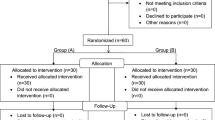Abstract
There has been continuing controversy regarding multiple tracts in a percutaneous nephrolithotomy (PCNL) session that may bring more complications, especially severe bleeding need for transfusion, even nephrectomy. Little tracts may bring less trauma to renal parenchyma than standard PCNL tracts. We carried minimally invasive PCNL (MPCNL) in treating staghorn calculi with multiple 16Fr percutaneous tracts in a single session, in an attempt to get high stone free with little trauma, and compared the morbidity of standard PCNL procedures in a prospective trial. A total of 54 consecutive patients with staghorn calculi were prospectively randomized for MPCNL (29) and PCNL (25). The size and location of stone, operative parameters, number of tracts, stone-free rate, operating time, hospital stay and complications were analyzed. In MPCNL group, a total of 67 percutaneous tracts were established in 29 renal units, while 28 tracts in 25 renal units in PCNL group. Compared to PCNL, MPCNL was associated with higher clearance rate (89.7 vs. 68%, p = 0.049), less chance need for adjunctive procedure of SWL or second-look PCNL (24.1 vs. 60%, p = 0.007), while a similar complication rate (37.9 vs. 52%, p = 0.300). In conclusion, with the development of instruments and increased experience, judiciously made multiple percutaneous tracts in a single session of MPCNL for treating staghorn calculi were safe, feasible and efficient with an acceptable morbidity.
Similar content being viewed by others
References
Koga S, Arakaki Y, Matsuoka M, Ohyama C (1991) Staghorn calculi: long-term results of management. BJU Int 68:122–124
Teichman JM, Long RD, Hulbert JC (1995) Long-term renal fate and prognosis after staghorn calculus management. J Urol 153:1403–1407
Chandhoke PS (1996) Cost-effectiveness of different treatment options for staghorn calculi. J Urol 156:1567–1571
Koko AK, Onuora VC, Al Turki MA, Mesbed AH, Al Jawini NA (2003) Extracorporeal shockwave lithotripsy monotherapy is not adequate for management of staghorn renal calculi. Saudi J Kidney Dis Transpl 14:487–491
Al-Kohlany KM, Shokeir AA, Mosbah A, Mohsen T, Shoma AM, Eraky I, El-Kenawy M, El-Kappany HA (2005) Treatment of complete staghorn stones: a prospective randomized comparison of open surgery versus percutaneous nephrolithotomy. J Urol 173:469–473
Segura JW, Preminger GM, Assimos DG, Dretler SP, Kahn RI, Lingeman JE, Macaluso JN Jr, McCullough DL (1994) Nephrolithiasis Clinical Guidelines Panel summary report on the management of staghorn calculi. The American Urological Association Nephrolithiasis Clinical Guidelines Panel. J Urol 151:1648–1651
Preminger GM, Assimos DG, Lingeman JE, Nakada SY, Pearle MS, Wolf JS Jr, AUA Nephrolithiasis Guideline Panel (2005) AUA guideline on management of staghorn calculi: diagnosis and treatment recommendations. J Urol 173:1991–2000
Aron M, Yadav R, Goel R, Kolla SB, Gautam G, Hemal AK, Gupta NP (2005) Multi-tract percutaneous nephrolithotomy for large complete staghorn calculi. Urol Int 75:327–332
Liatsikos EN, Kapoor R, Lee B, Jabbour M, Barbalias G, Smith AD (2005) “Angular percutaneous renal access” multiple tracts through a single incision for staghorn calculous treatment in a single session. Eur Urol 48:832–837
Singla M, Srivastava A, Kapoor R, Gupta N, Ansari MS, Dubey D, Kumar A (2008) Aggressive approach to staghorn calculi: safety and efficacy of multiple tracts percutaneous nephrolithotomy. Urology 71:1039–1042
Manohar T, Ganpule AP, Shrivastav P, Desai M (2006) Percutaneous nephrolithotomy for complex caliceal calculi and staghorn stones in children less than 5 years of age. J Endourol 20:547–551
Clayman RV, Elbers J, Miller RP, Williamson J, McKeel D, Wassynger W (1987) Percutaneous nephrostomy: assessment of renal damage associated with semi-rigid (24F) and balloons (36F) dilation. J Urol 138:203–206
Traxer O, Smith TG 3rd, Pearle MS, Corwin TS, Saboorian H, Cadeddu JA (2001) Renal parenchymal injury after standard and mini percutaneous nephrolithotomy. J Urol 165:1693–1695
Jackman SV, Hedican SP, Peters CA, Docimo SG (1998) Percutaneous nephrolithotomy in infants and preschool age children: experience with a new technique. Urology 52:697–701
Lahme S, Bichler KH, Strohmaier WL, Götz T (2001) Minimally invasive PCNL in patients with renal pelvic and calyceal stones. Eur Urol 40:619–624
Marguet CG, Springhart WP, Tan YH, Patel A, Undre S, Albala DM, Preminger GM (2005) Simultaneous combined use of flexible ureteroscopy and percutaneous nephrolithotomy to reduce the number of access tracts in the management of complex renal calculi. BJU Int 96:1097–1100
Martin X, Murat FJ, Feitosa LC, Rouvière O, Lyonnet D, Gelet A, Dubernard J (2000) Severe bleeding after nephrolithotomy: results of hyperselective embolization. Eur Urol 37:136–139
Turna B, Nazli O, Demiryoguran S, Mammadov R, Cal C (2007) Percutaneous nephrolithotomy: variables that influence hemorrhage. Urology 69:603–607
Lallas CD, Delvecchio FC, Evans BR, Silverstein AD, Preminger GM, Auge BK (2004) Management of nephropleural fistula after supracostal percutaneous nephrolithotomy. Urology 64:241–245
Shigeta M, Kasaoka Y, Yasumoto H, Inoue K, Usui T, Hayashi M, Tazuma S (1999) Fate of residual fragments after successful extracorporeal shock wave lithotripsy. Int J Urol 6:169–172
Author information
Authors and Affiliations
Corresponding author
Rights and permissions
About this article
Cite this article
Zhong, W., Zeng, G., Wu, W. et al. Minimally invasive percutaneous nephrolithotomy with multiple mini tracts in a single session in treating staghorn calculi. Urol Res 39, 117–122 (2011). https://doi.org/10.1007/s00240-010-0308-z
Received:
Accepted:
Published:
Issue Date:
DOI: https://doi.org/10.1007/s00240-010-0308-z



